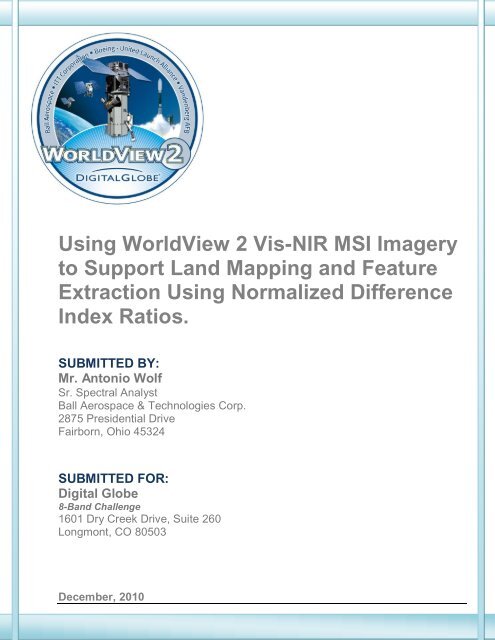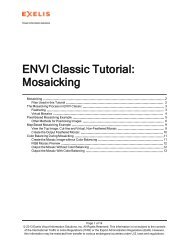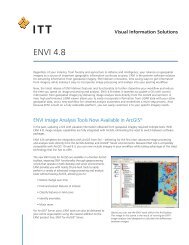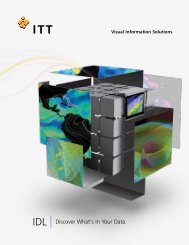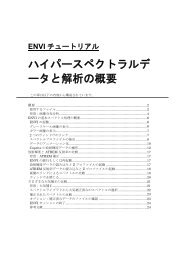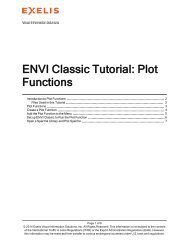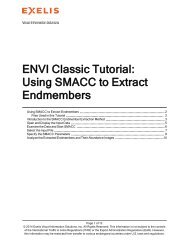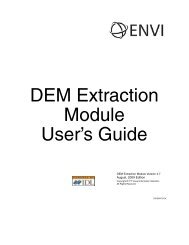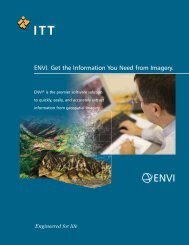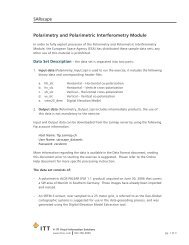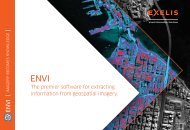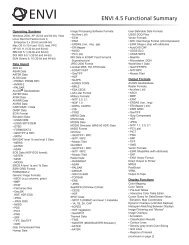Using WorldView 2 Vis-NIR MSI Imagery to Support Land Mapping ...
Using WorldView 2 Vis-NIR MSI Imagery to Support Land Mapping ...
Using WorldView 2 Vis-NIR MSI Imagery to Support Land Mapping ...
Create successful ePaper yourself
Turn your PDF publications into a flip-book with our unique Google optimized e-Paper software.
<strong>Using</strong> <strong>WorldView</strong> 2 <strong>Vis</strong>-<strong>NIR</strong> <strong>MSI</strong> <strong>Imagery</strong><br />
<strong>to</strong> <strong>Support</strong> <strong>Land</strong> <strong>Mapping</strong> and Feature<br />
Extraction <strong>Using</strong> Normalized Difference<br />
Index Ratios.<br />
SUBMITTED BY:<br />
Mr. An<strong>to</strong>nio Wolf<br />
Sr. Spectral Analyst<br />
Ball Aerospace & Technologies Corp.<br />
2875 Presidential Drive<br />
Fairborn, Ohio 45324<br />
SUBMITTED FOR:<br />
Digital Globe<br />
8-Band Challenge<br />
1601 Dry Creek Drive, Suite 260<br />
Longmont, CO 80503<br />
December, 2010
Executive Summary<br />
Multispectral imagery (<strong>MSI</strong>) provides information <strong>to</strong> support decision making across a growing number<br />
of private and industrial applications. Among them, land mapping, terrain classification and feature extraction<br />
rank highly in the interest of those who analyze the data <strong>to</strong> produce information, reports, and intelligence<br />
products. The 8 nominal band centers of <strong>WorldView</strong> 2 allow us <strong>to</strong> use non-traditional means of measuring the<br />
differences which exist in the features, artifacts, and surface materials in the data, and we are able <strong>to</strong> determine<br />
the most effective method for processing this information by exploiting the unique response values within<br />
those wavelength channels. The difference in responses across select bands can be sought using normalized<br />
difference index ratios <strong>to</strong> measure moisture content, indicate vegetation health, and distinguish natural features<br />
from man-made objects. The focus of this effort is <strong>to</strong> develop an approach <strong>to</strong> measure, identify and<br />
threshold these differences in order <strong>to</strong> establish an effective land mapping and feature extraction process<br />
germane <strong>to</strong> <strong>WorldView</strong> 2 imagery.<br />
1.0 <strong>WorldView</strong> 2 Specifications<br />
The <strong>WorldView</strong> 2 sensor is the first commercial <strong>MSI</strong> sensor of its kind. Advancing from the spatial advantages<br />
of <strong>WorldView</strong> I, it has remarkable 46cm panchromatic optics on-board at nadir. Each swath measures<br />
16.4km and can s<strong>to</strong>re up <strong>to</strong> 2199GB on solid state drives, complete with EDAC. <strong>WorldView</strong> 2 can register<br />
objects on the ground within 6.5m, and register ground control points within 2m accuracy. The temporal revisit<br />
time of the sensor is 1.1 day at 1m ground sample distance, giving users an advantage of having changes<br />
detected within any scene in a mere matter of hours. Each band has a dynamic range of 11bit radiometric resolution,<br />
and data is transferred <strong>to</strong> the ground station over the 800mbps X-band downlink.<br />
The 8 spectral bands of <strong>WorldView</strong> 2 offer a unique perspective of the data within each scene. Unlike<br />
traditional <strong>MSI</strong> systems, <strong>WorldView</strong> 2 captures the coastal, yellow, red edge, and <strong>NIR</strong> 2 wavelengths, as illustrated<br />
in Figure 1-1.<br />
Figure 1-1: The 8 spectral bands (and panchromatic band) of <strong>WorldView</strong> 2.<br />
2
2.0 Analysis<br />
The <strong>WorldView</strong> 2 multispectral imager is the first sensor of its kind <strong>to</strong> capture the ‘yellow’, ‘red edge’,<br />
‘coastal’, and 2 separate <strong>NIR</strong> spectral ranges in a single focal plane, coupled with traditional visible wavelengths.<br />
These unique channels will grant the analyst access <strong>to</strong> spectral regions where distinguishable differences<br />
exist between multiple classifications within the scene, which may be overlooked by more traditional<br />
<strong>MSI</strong> systems. Those classifications become more well-defined once they are transformed along a new axis, and<br />
<strong>WorldView</strong> 2 has the advantage of using non-traditional wavelengths, which may foster more specific results<br />
from this transformation.<br />
Index ratios are typically used <strong>to</strong> classify a particular material or feature, and are dictated by the difference<br />
in reflectance values between the bands used in the ratio. Traditionally, water and vegetation have been<br />
the primary focus of normalized index ratios because they are easy <strong>to</strong> identify by the difference in reflectance<br />
values between the 0.45µ, 0.65µ and 0.75µ channels. <strong>WorldView</strong> 2 provides us with a coastal region band<br />
(0.427µ) which could be used <strong>to</strong> produce a more accurate index ratio <strong>to</strong> represent areas of subtle moisture<br />
within the scene, as opposed <strong>to</strong> complete saturation or standing water. This allows the ratio <strong>to</strong> classify areas<br />
of “in-between” response values, such as soil and surface moisture levels, which are not exploitable by traditional<br />
V-<strong>NIR</strong> <strong>MSI</strong> systems.<br />
With regard <strong>to</strong> land mapping, index ratios can be used <strong>to</strong> establish the foundation of classifications,<br />
from identifying the most abundant surface materials, <strong>to</strong> drawing discrete differences in the health, condition<br />
and variety of other natural and man-made features. Systems such as <strong>Land</strong>sat 7 ETM have provided the capability<br />
<strong>to</strong> distinguish characteristics in the data which foster a high-level land use analysis, using standard <strong>Vis</strong>-<br />
<strong>NIR</strong> wavelengths. <strong>WorldView</strong> 2 could provide an exponential number of more characteristics than traditional<br />
systems such as <strong>Land</strong>sat based on the product of indexing the ‘coastal’, ‘yellow’, and multiple <strong>NIR</strong> bands.<br />
The product of each index ratio is considered an independent element of the land map, and <strong>to</strong>gether<br />
the elements comprise a composite image which describes the classifications of the scene. In essence, ratios<br />
are individual nodes along the processing chain, which contribute <strong>to</strong> the overall mosaic of land mapping. The<br />
objective of this study is <strong>to</strong> assess the unique utility of <strong>WorldView</strong> 2 imagery with respect <strong>to</strong> utilizing multiple<br />
index ratios <strong>to</strong> produce a more accurate land mapping method than that of traditional <strong>MSI</strong>.<br />
2.1 Index Ratios<br />
In order <strong>to</strong> exploit specific features which can be used <strong>to</strong> support land mapping applications, you must<br />
first derive the information using index ratios which are germane <strong>to</strong> each classification included in the land<br />
map composite. For instance, regions of soil moisture are derived using a ratio using the coastal band and<br />
the second <strong>NIR</strong> band, whereas regions of standing water are derived from a ratio using the blue band and<br />
the first <strong>NIR</strong> band. The same logic applies <strong>to</strong> mapping vegetation (scaled by health), man-made features,<br />
regions of dense soil, and other natural features identified by their unique spectral content. Ratios <strong>to</strong> be<br />
used for the practice of establishing effective land mapping means using <strong>WorldView</strong> 2 imagery are listed in<br />
table 2-1.<br />
3
Index Ratio Purpose<br />
Normalized Difference Water Index (NDWI) Identify areas of standing water in size greater than<br />
one pixel<br />
Normalized Difference Vegetation Index (NDVI) Identify areas of vegetation and determine the health<br />
of each vegetation class.<br />
Normalized Difference Soil Index (NDSI) Identify areas where soils is the dominant background<br />
or foreground material<br />
Non-Homogeneous Feature Difference (NHFD) Classifying areas which contrast against the background,<br />
which can be identified as man-made<br />
Table 2-1: The index ratios proposed <strong>to</strong> support land mapping methods using <strong>WorldView</strong> 2 imagery<br />
The difference which exists between the response values in the ratio will dictate where the respective<br />
classifications lie in the scene. Once these areas are identified, the detection threshold values can be set <strong>to</strong><br />
capture only the feasible regions of classification. After the thresholds are set, the regions can then be classified<br />
as areas having specific characteristics with respect <strong>to</strong> the land map. Each region is then overlaid on<strong>to</strong> a<br />
single projected image, and annotations will identify each region being a particular class (i.e. water, soil,<br />
healthy vegetation etc.), generating the land map. Each of the new unique bands is used in the ratio in order<br />
<strong>to</strong> provide context <strong>to</strong> the utility of these wavelengths with respect <strong>to</strong> traditional analysis techniques.<br />
2.1.1 NDWI<br />
= NDWI<br />
Traditionally, a blue band is normalized against a <strong>NIR</strong> band, since the difference in response is very obvious.<br />
In this case, we take the coastal band, and normalize that against the <strong>NIR</strong>2 band, since the difference<br />
that each of these unique bands gives us, is even greater, hence will provide an even more discrete threshold<br />
for detecting areas of standing water.<br />
2.1.2 NDVI<br />
= NDVI<br />
Given any other <strong>MSI</strong> system, a red band is used <strong>to</strong> represent the low level of reflectance from vegetation<br />
and a broad <strong>NIR</strong> <strong>to</strong> represent the higher reflectance values. The red band stays true <strong>to</strong> lower reflectance<br />
levels than the <strong>NIR</strong>2 band, which has a higher value than traditional broad <strong>NIR</strong> bands, hence should produce a<br />
higher NDVI value<br />
2.1.3 NDSI<br />
= NDSI<br />
4
Normally, SWIR and <strong>NIR</strong> bands are used <strong>to</strong> represent the difference in reflectance values in soil areas.<br />
Since there is no SWIR band, but there are unique differences in the response values of soil between the green<br />
and yellow bands, this artifact can be exploited <strong>to</strong> represent soil.<br />
2.1.4 NHFD<br />
= NHFD<br />
Non-homogeneous features tend <strong>to</strong> stand out brighter in response than the background. To exploit<br />
these features, the difference between the red edge and coastal bands will provide an effective means of segregating<br />
these features.<br />
This type of analysis is indigenous <strong>to</strong> each collection, and the data must be calibrated and atmospherically<br />
corrected prior <strong>to</strong> classification. To do this, the ENVI <strong>WorldView</strong> Calibration algorithm will be used <strong>to</strong><br />
convert the raw digital numbers <strong>to</strong> radiance values, ensuring that each response is free of most scattering and<br />
artifacts. It is important <strong>to</strong> use sanctioned correction methods such as the ENVI <strong>WorldView</strong> correction, and not<br />
arbitrary techniques such as IARR, or QUAC, <strong>to</strong> ensure that the results are consistent and valid. This study<br />
does not assess the quality of the radiometric calibration of <strong>WorldView</strong> 2 imagery, nor will it compromise any<br />
integrity of the data by attempting <strong>to</strong> base classification on the result of any dimensional transformation of<br />
the data.<br />
Furthermore, once this analysis is complete, a further analysis will compare the attributes of this study<br />
<strong>to</strong> that of other commercial assets including Quickbird 2, and <strong>Land</strong>sat 7 ETM, in order <strong>to</strong> provide perspective<br />
on the advantages of using <strong>WorldView</strong> 2. This is <strong>to</strong> shed insight regarding the utility of this sensor in other civil<br />
applications.<br />
2.2 Description of Data<br />
All data used in this study is standard<br />
<strong>WorldView</strong> 2 collection file format (raw digital<br />
number, .Tiff), including all geo-registration information<br />
and full 8 spectral band data. The<br />
calibration metadata used in order <strong>to</strong> convert<br />
the raw digital numbers <strong>to</strong> radiance is also necessary.<br />
This information is adequate <strong>to</strong> produce<br />
the most accurate and effective land map<br />
applications. Included with this data package is<br />
the corresponding EO panchromatic data that<br />
will provide spatial context for further analysis.<br />
Figure 2.2-1 provides details of the data which<br />
is used in this analysis.<br />
Figure 2.2-1: Description of the data used in the analysis.<br />
5
2.3 Processing Chain<br />
A series of pre-processing steps must be performed in order <strong>to</strong> prepare the radiometric integrity of the<br />
data, and spatially mosaic all separated images. Once pre-processing is complete, the index ratios will be calculated<br />
against the data, and the results compiled in<strong>to</strong> a land map.<br />
still proficient for providing an equal context for all radiometric data regardless.<br />
First, the data must be mosaicked<br />
from its original form of 9<br />
separate images (based on GCP information),<br />
in<strong>to</strong> a single image that<br />
contains undis<strong>to</strong>rted spectral integrity.<br />
Some forms of this process will<br />
often dis<strong>to</strong>rt the data, but the ENVI<br />
mosaic utility, used in this scenario,<br />
keeps all original band information<br />
intact. Next, a dark pixel subtraction<br />
is run against the data in order <strong>to</strong><br />
spread the data values evenly in<br />
space with regard <strong>to</strong> dynamic range.<br />
This step is often performed on systems<br />
that vary in radiometric range<br />
among bands, however, since<br />
<strong>WorldView</strong> 2 is uniform 11bit, it is<br />
The next step is <strong>to</strong> convert the raw digital number values <strong>to</strong> radiance fac<strong>to</strong>rs by applying the ENVI<br />
<strong>WorldView</strong> Calibration utility, available in ENVI v4.6 and greater. This <strong>to</strong>ol takes the fac<strong>to</strong>rs from the<br />
<strong>WorldView</strong> 2 metadata (provided) and applies the appropriate gains and offsets in order <strong>to</strong> convert those values<br />
<strong>to</strong> apparent radiance. This will remove enough of the atmospheric artifacts <strong>to</strong> provide valid intensity levels<br />
in the spectra.<br />
Next, the index ratio is calculated against the values in the radiance cube, and an output image is generated.<br />
Once each output is produced, the individual result images will be layered in<strong>to</strong> one final land map dataset.<br />
This land map will be the final output of this analysis. This processing chain is illustrated in Figure 2.3-1.<br />
3.0 Results<br />
Figure 2.2-1: The processing chain for this analysis, from preprocessing<br />
through final product generation.<br />
Results from this study are quite good, and fulfilling <strong>to</strong> the purpose of this research. Each index ratio<br />
performed as theorized, and thresholds were applied <strong>to</strong> mitigate any false alarms, which were minimal from<br />
default threshold settings. Each ratio produced what most analysts would consider feasible results which pass<br />
the common sense filter, meaning areas of obvious similarities are apparent in both the true/false color composites<br />
of the original data, and the classification regions within the land map.<br />
6
NDWI Result<br />
There are several large bodies<br />
of water present in the scene, and<br />
each emits a similar response exploited<br />
by the NDWI ratio. Figure 3-1<br />
below is the result of the NDWI ratio<br />
with a comparison of obvious regions<br />
of standing water in the false color<br />
composite.<br />
As Figure 3-1 illustrates, the<br />
obvious detection of standing water<br />
validates the theory that the coastal<br />
band is a unique variable in the NDWI<br />
equation. As a second phase of validation,<br />
the same process was run again,<br />
using the blue band in place of the<br />
coastal band. As a result, the threshold had <strong>to</strong> be increased <strong>to</strong> filter out a larger number of false alarms, making<br />
the coastal band an advantageous asset <strong>to</strong> the NDWI ratio over traditional blue bands. This is not surprising,<br />
as in many cases the response of the coastal band was greater than the blue band in areas of standing water.<br />
NDVI Result<br />
There are many civil applications which benefit from the use of an NDVI ratio, which has been an industry<br />
standard for years. Until now, the use of the red and the <strong>NIR</strong> bands have provided enough substance <strong>to</strong><br />
classify areas of vegetation health. The advantage <strong>to</strong> having the <strong>NIR</strong>2 band is that the difference in response<br />
values between the two regions is even greater, thus widening the threshold for positive classifications of vegetation,<br />
and the level of health (varied by intensity). Figure 3-2 illustrates the result of the NDVI ratio.<br />
Figure 3-2: The NDVI result shows areas where vegetation was<br />
detected within the scene, of varying health and size.<br />
Figure 3-1: The NDWI result shows areas where water was detected<br />
within the scene.<br />
From the false color composite in<br />
Figure 3-2, the areas of bright red response<br />
dictate areas of healthy vegetation,<br />
represented by athletic<br />
fields/venues, parks, and even a golf<br />
course (cursor location). The high <strong>NIR</strong>2<br />
response gives context <strong>to</strong> the utility of<br />
this method of NDVI. Lighter areas in the<br />
result image dictate regions where the<br />
<strong>NIR</strong>2 response was not as high, but still<br />
apparent, insinuating that the health of<br />
the vegetation sample is not as matured<br />
or seasoned as the darker response regions.<br />
7
NDSI Result<br />
As mentioned, typically a soil index ratio requires a SWIR band, since soils tend <strong>to</strong> stay bright or gain<br />
intensity as they are recorded in higher wavelengths. Drawing from a sample of the soil within the scene, a<br />
consistent and unique difference<br />
between the green and yellow<br />
bands was observed. The theory<br />
that this is constant for all regions of<br />
soil was proven valid, as shown in<br />
Figure 3-3.<br />
The NDSI is quite possibly<br />
the most impressive result of them<br />
all. All detections were validated by<br />
cross referencing the signatures in<br />
each corresponding region in the<br />
true and false color composites with<br />
the detections in the NDSI. This is a<br />
remarkable, and valid, new method of<br />
determining areas of soil content with-<br />
out using a SWIR band. This is the largest sample of the index ratios <strong>to</strong> be applied <strong>to</strong> the land map.<br />
NHFD Result<br />
Man-made materials are often the most simple <strong>to</strong> extract from homogeneous backgrounds, but in this<br />
scenario, the background consists of many different types of materials. However, the performance of the<br />
NHFD was outstanding, detecting not only the most obvious of stand-out materials (building roofs, cars), but<br />
paved surfaces (roads) and even obscure static objects such as tennis courts were detected by the NHFD.<br />
<strong>Using</strong> the red edge and coastal bands in order <strong>to</strong> detect man-made materials is 100% germane <strong>to</strong><br />
<strong>WorldView</strong> 2 utility, as no other<br />
sensor can provide this type of<br />
result. As shown in the result image<br />
in Figure 3-4, the paved surfaces<br />
(even in<strong>to</strong> urban crosssections)<br />
are apparent, as are the<br />
larger structures that stand out,<br />
such as large buildings and residences.<br />
This is the second most<br />
abundant layer <strong>to</strong> be applied <strong>to</strong><br />
the land map.<br />
Figure 3-4: The NHFD result shows areas and places where man-made<br />
objects are located/installed.<br />
Figure 3-3: The NDSI result illustrates areas where soils were detected<br />
within the scene.<br />
8
<strong>Land</strong> Map Result<br />
Once the index ratio result layers were compiled <strong>to</strong> form a single land map, a color map was applied <strong>to</strong><br />
the scene, giving context <strong>to</strong> each of the individual results. The greatest attribute <strong>to</strong> the validity of this analysis<br />
is that no layers overlap in this land map. Typically, regions of classification are not set <strong>to</strong> reasonable thresholds<br />
where false alarms still exist, but false alarms in this dataset have been completely mitigated by the<br />
previous application of a threshold <strong>to</strong> the result layer. Figure 3-5 is the result of the land map which was produced.<br />
Transforms such as Principal Components Analysis (PCA) and Minimum Noise fraction (MNF) were<br />
created so that this process becomes streamlined, in the instance that an entire scene should be classified.<br />
However, these processes redistribute the spectral variance along a new set of axis, with respect <strong>to</strong> spectral<br />
dimensionality. In this case, only specific types of materials needed <strong>to</strong> be identified, as is the case for most<br />
commercial applications that rely on <strong>MSI</strong> data. Comparing the results of these index ratios with that of a PCA<br />
or MNF is not valid for<br />
the purpose of this<br />
study, it is intended <strong>to</strong><br />
express the unique<br />
utility of these bands<br />
when used in context<br />
of feature extraction<br />
<strong>to</strong> support land mapping.<br />
Figure 3-5: The final<br />
product; a land map<br />
generated from the index<br />
ratios using the<br />
unique <strong>WorldView</strong> 2<br />
bands.<br />
Essentially, the<br />
data has come a long<br />
way in the essence that each individual scan (9x9) provided enough calibrated substance <strong>to</strong> support generating<br />
a valid wide area land map. In reality, the analysis itself was by no means complex, and required very little<br />
pre-processing in order <strong>to</strong> attain these results. This type of process could become streamlined in order <strong>to</strong> provide<br />
an “on-the-fly” approach <strong>to</strong> generating this type of product, which is very easy for end-users <strong>to</strong> understand.<br />
As mentioned previously, these results exceeded the expectations, as they break the norms of all<br />
things considered <strong>to</strong> be textbook rules when it comes <strong>to</strong> using index ratios <strong>to</strong> support feature extraction <strong>to</strong><br />
create land maps. In the further analysis section of this study, other attributes and observations taken from<br />
this research are explained, fostering more advantages <strong>to</strong> using <strong>WorldView</strong> 2 data over other commercial <strong>MSI</strong><br />
assets.<br />
9
4.0 Further Analysis<br />
<strong>WorldView</strong> 2 and Quickbird 2: Comparison of Pan-Sharpening<br />
A number of observations from this study provide insight <strong>to</strong> the true utility and robust capability that<br />
<strong>WorldView</strong> 2 brings <strong>to</strong> the commercial <strong>MSI</strong> arena. There are a number of techniques that combine two or<br />
more processes or transformations <strong>to</strong> the imagery which place more contexts in the information provided by<br />
the data. As an example, a spectral cube fused with EO panchromatic imagery, or Pan-Sharpening, can provide<br />
more detailed classification mapping in the scene. The spatial resolution of the EO imagery is the single variable<br />
that defines how much context is truly added <strong>to</strong> the analysis. Until now, Quickbird 2 has provided access <strong>to</strong><br />
this type of information, with sub-meter panchromatic resolution. <strong>WorldView</strong> 2 provides even more spatial<br />
content, and even more so within the realm of the 8 spectral bands. From this, we can draw that <strong>WorldView</strong> 2<br />
should be superior for performing this type of analysis, and Figure 4-1 illustrates that this is a valid assumption.<br />
Figure 4-1:<br />
Quickbird 2<br />
Pan-Sharpened<br />
<strong>MSI</strong> vs.<br />
<strong>WorldView</strong> 2<br />
Pan-Sharpened<br />
<strong>MSI</strong><br />
At first<br />
glimpse, the<br />
two images in<br />
Figure 4-1 may<br />
not seem so<br />
different, until<br />
the reader understands<br />
what they are<br />
looking at. The<br />
Quickbird 2<br />
image is of a large chemical processing facility. Although crisp, the resolution does not come close <strong>to</strong> the level<br />
of detail drawn out by the <strong>WorldView</strong> 2 image of the University of Colorado football stadium, where individual<br />
rows of bleachers can be depicted at reasonable zoom levels. Specifications would suggest that <strong>WorldView</strong> 2<br />
should be sharper at greater zoom levels, and this is a true assumption, as illustrated in this example.<br />
<strong>WorldView</strong> 2 not only exceeds the spatial capability of Quickbird, but also exceeds the spectral resolution with<br />
twice as many bands available.<br />
<strong>WorldView</strong> 2 and <strong>Land</strong>Sat 7 ETM: Comparison of Spectral/Spatial Context<br />
For years, the <strong>Land</strong>sat 7 ETM has provided spectral context for wide-area coverage, and done so for<br />
many purposes. Today, <strong>WorldView</strong> 2 provides a very large footprint for wide-area coverage, and can provide<br />
much more spectral depth.<br />
10
Though <strong>WorldView</strong> 2 cannot provide MWIR responses, it is capable of providing very low level scene<br />
classification for the entire footprint, whereas <strong>Land</strong>Sat 7 ETM is fixed providing > 10m spectral/spatial context.<br />
Take for instance the need <strong>to</strong> use a Minimum Noise Fraction forward transformation in order <strong>to</strong> discern materials<br />
and objects in the scene. The next step is <strong>to</strong> fuse that information with high resolution EO imagery, in order<br />
<strong>to</strong> provide even more spatial context <strong>to</strong> the product. Both systems are capable of providing the necessary<br />
data, but <strong>WorldView</strong> 2 provides a<br />
much higher resolution result, for a<br />
very wide area of regard. Figure 4-<br />
2 and 4-3 illustrate the difference<br />
between the two systems when<br />
performing the same task. Note,<br />
the <strong>WorldView</strong> 2 sample provides<br />
almost as much context after the<br />
MNF transformation and pansharpening,<br />
as when only pansharpening<br />
was performed in the<br />
previous Quickbird 2 example.<br />
Figure 4-2: Comparison of MNF results<br />
among <strong>Land</strong>Sat 7 ETM and<br />
<strong>WorldView</strong> 2.<br />
A subset of the data is then taken from the MNF result layer and sharpened with the high-resolution<br />
EO <strong>to</strong> produce a very high detailed MNF layer.<br />
Figure 4-3: A subset of the MNF post pan-sharpening, provides very high detailed<br />
classification.<br />
From this example, the<br />
<strong>WorldView</strong> 2 imagery possesses<br />
a capability unlike any other<br />
sensor in its class, and provides<br />
further utility in the commercial<br />
<strong>MSI</strong> realm across many civil applications.<br />
Although <strong>Land</strong>Sat 7<br />
ETM is still useful for assessing<br />
trends in large scale fashion, the<br />
short re-visit time of <strong>WorldView</strong><br />
2 makes it possible <strong>to</strong> gather the<br />
same amount of large scale information,<br />
with greater spectral<br />
depth, in a very short amount of<br />
time. It is the belief of the author<br />
that systems such as<br />
<strong>WorldView</strong> 2 will continue <strong>to</strong><br />
phase out older systems such as<br />
<strong>Land</strong>sat 7 ETM, due <strong>to</strong> their<br />
growing capabilities, access <strong>to</strong><br />
data, and ease of processing.<br />
11
5.0 Conclusion<br />
Results from this analysis are substance that such methods do provide an effective method <strong>to</strong> support<br />
land mapping across a large number of growing applications, who would benefit from exploiting the unique<br />
capabilities of <strong>WorldView</strong> 2 data. It was the intent of the author <strong>to</strong> comprise a number of unique normalized<br />
difference index ratios <strong>to</strong> provide accurate analysis of the data, and foster new capability using <strong>WorldView</strong> 2<br />
imagery. Thus, the resulting product, a simple land map, proves that these ratios do in fact validate the integrity<br />
of the unique index ratios with respect <strong>to</strong> <strong>WorldView</strong> 2 <strong>MSI</strong>.<br />
Further, utilizing the unique bands of <strong>WorldView</strong> 2 offers a contextual foundation for land mapping<br />
and scene characterization unlike any other commercial <strong>MSI</strong> sensor. The unique bands push the spectral resolution<br />
of commercial <strong>MSI</strong>, and foster new feature extraction methods <strong>to</strong> support land mapping. This analysis<br />
proves that these new and unique index ratios are a valid means of performing feature extraction. This information,<br />
fused with other types of image and data processing, could grow the commercial user base, as this<br />
approach proves that using this data is simple. Very little pre-processing is necessary in order <strong>to</strong> perform advanced<br />
analysis techniques, and that is something that the everyday remote sensing data analyst can appreciate.<br />
6.0 Summary<br />
The objective of this study was <strong>to</strong> establish effective index ratios using the unique spectral bands of<br />
<strong>WorldView</strong> 2 imagery <strong>to</strong> enhance land mapping methods. Identifying such methods would standardize an efficient<br />
way <strong>to</strong> support land mapping across a large number of growing applications, which could benefit from<br />
the unique capabilities of <strong>WorldView</strong> 2 data. The intent of the author was <strong>to</strong> provide new means for analysis<br />
of <strong>WorldView</strong> 2 data, by comprising unique normalized difference index ratios, and foster new utility of the<br />
imagery. Each ratio comprised of at least one unique band from the arsenal of newly available wavelengths<br />
(coastal, yellow, red edge, and <strong>NIR</strong>2) which are not common of any other platform in the commercial <strong>MSI</strong><br />
realm.<br />
The results are valid and optimistic. Each ratio provides a unique method of extracting features from within<br />
the scene <strong>to</strong> create a solid approach <strong>to</strong> generating land maps. From the results of this study, it is clear that<br />
the number of civil applications which rely on traditional <strong>MSI</strong> should consider acquiring <strong>WorldView</strong> 2 imagery<br />
<strong>to</strong> support their mission and achieve greater objectives.<br />
12
Contributions<br />
Several individuals have made this study successful, and the author wishes <strong>to</strong> thank them for their<br />
support and contributions <strong>to</strong> research.<br />
Mr. Ian Gilbert, DigitalGlobe Inc.<br />
DigitalGlobe 8 Band Challenge Committee<br />
Mr. Thomas Jones, Mr. Mark Bowersox, and Mr. Chris<strong>to</strong>pher Jengo, ITT Corp.<br />
Ms. Peggy Irwin and Mr. Vance Saunders, Ball Aerospace and Technologies Corp.<br />
Mr. Kip Streithorst, Mr. Gary Welch, and Mr. Trevor Clarke, Opticks Development Team<br />
About the Author<br />
An<strong>to</strong>nio (Tony) Wolf has 8 years of experience as a multi/hyperspectral data analyst<br />
and sensor utility assessor, working at the National Air and Space Intelligence Center.<br />
Mr. Wolf has specialized in standardizing processing techniques for a broad number<br />
of spectral imaging systems including <strong>Land</strong>Sat ETM, Quickbird 2, ASTER, and now<br />
<strong>WorldView</strong> 2. During his Masters studies at the University of Colorado, he has focused<br />
his efforts on benchmarking sensor specific methods for transforming, calibrating and<br />
processing changes within <strong>Vis</strong>/<strong>NIR</strong> data. Today, Tony supports the systems, architecture<br />
and analysis side of HSI sensor development, and provides training at the Advanced<br />
Technical Intelligence Center for using Opticks, an open-source remote sensing software platform.<br />
Other publications have included:<br />
o Spectral binning optimization for the ARTEMIS real-time processor<br />
(Wolf, Petrick, Wamsley, Johnson, Buswell, Ewald, Pachter, Grigsby)<br />
Imaging Spectrometry XIII. Edited by Shen, Sylvia S.; Lewis, Paul E. Proceedings of the SPIE, Volume 7086, pp. 70860R-<br />
70860R-7 (2008)<br />
o Utility Assessment of the Advanced Change Detection and Thematic <strong>Mapping</strong> Classification Algorithms<br />
<strong>to</strong> <strong>Support</strong> Urban Development<br />
(Wolf)<br />
Advanced Remote Sensing Technical Volume, The University of Colorado, May 2010<br />
o Sub-Pixel Target Detection Performance of a Novel Panchromatic Sharpening Technique for Hyperspectral<br />
Image Data<br />
(Borel, Wolf, Ewald, Wamsley)<br />
Submission 2010 IEEE Aerospace Conference<br />
o Spectral Registration Utility Assessment of the Compact Airborne Spectral Sensor (COMPASS)<br />
(Wolf, Johnson)<br />
Submission and presentation 2005 Spectral Analyst Exchange Forum<br />
13


